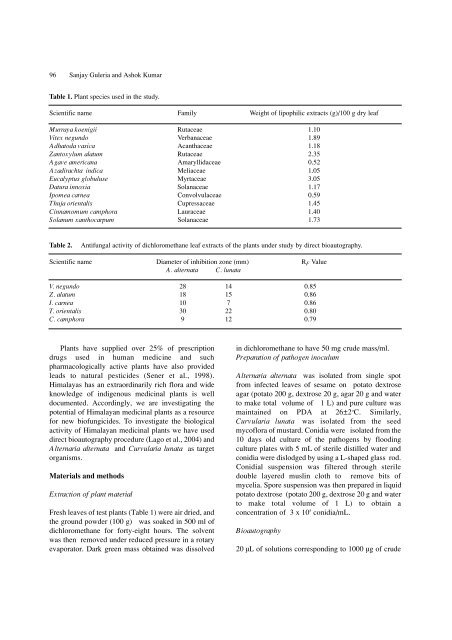Antifungal activity of some Himalayan medicinal plants using direct ...
Antifungal activity of some Himalayan medicinal plants using direct ...
Antifungal activity of some Himalayan medicinal plants using direct ...
You also want an ePaper? Increase the reach of your titles
YUMPU automatically turns print PDFs into web optimized ePapers that Google loves.
96 Sanjay Guleria and Ashok Kumar<br />
Table 1. Plant species used in the study.<br />
Scientific name Family Weight <strong>of</strong> lipophilic extracts (g)/100 g dry leaf<br />
Murraya koenigii Rutaceae 1.10<br />
Vitex negundo Verbanaceae 1.89<br />
Adhatoda vasica Acanthaceae 1.18<br />
Zantoxylum alatum Rutaceae 2.35<br />
Agave americana Amaryllidaceae 0.52<br />
Azadirachta indica Meliaceae 1.05<br />
Eucalyptus globuluse Myrtaceae 3.05<br />
Datura innoxia Solanaceae 1.17<br />
Ipomea carnea Convolvulaceae 0.59<br />
Thuja orientalis Cupressaceae 1.45<br />
Cinnamomum camphora Lauraceae 1.40<br />
Solanum xanthocarpum Solanaceae 1.73<br />
Table 2. <strong>Antifungal</strong> <strong>activity</strong> <strong>of</strong> dichloromethane leaf extracts <strong>of</strong> the <strong>plants</strong> under study by <strong>direct</strong> bioautography.<br />
Scientific name Diameter <strong>of</strong> inhibition zone (mm) R F Value<br />
A. alternata C. lunata<br />
V. negundo 28 14 0.85<br />
Z. alatum 18 15 0.86<br />
I. carnea 10 7 0.86<br />
T. orientalis 30 22 0.80<br />
C. camphora 9 12 0.79<br />
Plants have supplied over 25% <strong>of</strong> prescription<br />
drugs used in human medicine and such<br />
pharmacologically active <strong>plants</strong> have also provided<br />
leads to natural pesticides (Sener et al., 1998).<br />
Himalayas has an extraordinarily rich flora and wide<br />
knowledge <strong>of</strong> indigenous <strong>medicinal</strong> <strong>plants</strong> is well<br />
documented. Accordingly, we are investigating the<br />
potential <strong>of</strong> <strong>Himalayan</strong> <strong>medicinal</strong> <strong>plants</strong> as a resource<br />
for new bi<strong>of</strong>ungicides. To investigate the biological<br />
<strong>activity</strong> <strong>of</strong> <strong>Himalayan</strong> <strong>medicinal</strong> <strong>plants</strong> we have used<br />
<strong>direct</strong> bioautography procedure (Lago et al., 2004) and<br />
Alternaria alternata and Curvularia lunata as target<br />
organisms.<br />
Materials and methods<br />
Extraction <strong>of</strong> plant material<br />
Fresh leaves <strong>of</strong> test <strong>plants</strong> (Table 1) were air dried, and<br />
the ground powder (100 g) was soaked in 500 ml <strong>of</strong><br />
dichloromethane for forty-eight hours. The solvent<br />
was then removed under reduced pressure in a rotary<br />
evaporator. Dark green mass obtained was dissolved<br />
in dichloromethane to have 50 mg crude mass/ml.<br />
P reparation <strong>of</strong> pathogen inoculum<br />
Alternaria alternata was isolated from single spot<br />
from infected leaves <strong>of</strong> sesame on potato dextrose<br />
agar (potato 200 g, dextrose 20 g, agar 20 g and water<br />
to make total volume <strong>of</strong> 1 L) and pure culture was<br />
maintained on PDA at 26±2 o C. Similarly,<br />
Curvularia lunata was isolated from the seed<br />
myc<strong>of</strong>lora <strong>of</strong> mustard. Conidia were isolated from the<br />
10 days old culture <strong>of</strong> the pathogens by flooding<br />
culture plates with 5 mL <strong>of</strong> sterile distilled water and<br />
conidia were dislodged by <strong>using</strong> a L-shaped glass rod.<br />
Conidial suspension was filtered through sterile<br />
double layered muslin cloth to remove bits <strong>of</strong><br />
mycelia. Spore suspension was then prepared in liquid<br />
potato dextrose (potato 200 g, dextrose 20 g and water<br />
to make total volume <strong>of</strong> 1 L) to obtain a<br />
concentration <strong>of</strong> 3 x 10 5 conidia/mL.<br />
Bioautography<br />
20 µL <strong>of</strong> solutions corresponding to 1000 µg <strong>of</strong> crude
















